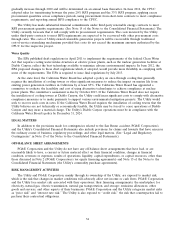PG&E 2012 Annual Report Download - page 47
Download and view the complete annual report
Please find page 47 of the 2012 PG&E annual report below. You can navigate through the pages in the report by either clicking on the pages listed below, or by using the keyword search tool below to find specific information within the annual report.The Utility’s failure to recover its operating expenses, including electricity and natural gas procurement costs in
a timely manner through rates could have a material effect on PG&E Corporation’s and the Utility’s financial
condition, results of operations, and cash flows.
The Utility’s ability to procure electricity to meet customer demand at reasonable prices and recover procurement costs timely
may be affected by increasing renewable energy requirements, the continuing functioning of the wholesale electricity market
in California, and the new cap-and-trade market.
The Utility meets customer demand for electricity from a variety of sources, including electricity generated from
the Utility’s own generation facilities, electricity provided by third parties under power purchase agreements, and
purchases on the wholesale electricity market. The Utility must manage these sources using the principles of ‘‘least
cost dispatch.’’
The Utility enters into power purchase agreements, including contracts to purchase renewable energy, in
compliance with a long-term procurement plan approved by the CPUC. The Utility executes power purchase
agreements following competitive requests for offers. The Utility submits the winning contracts to the CPUC for
approval and authorization to recover contract costs through rates. There is a risk that the contractual prices the
Utility is required to pay will become uneconomic in the future for a variety of reasons, including developments in
alternative energy technology, increased self-generation by customers, an increase in distributed generation, and
lower customer demand due to economic conditions or the loss of the Utility’s customers to other generation
providers. In particular, as the market for renewable energy develops in response to California’s renewable energy
requirements, there is a risk that the Utility’s contractual commitments could result in procurement costs that are
higher than the market price of renewable energy. This could create a further risk that, despite original CPUC
approval of the contracts, the CPUC would disallow contract costs in the future if the CPUC determines that the
costs are unreasonably above market. In addition, the CPUC could disallow procurement costs if the CPUC
determined that the Utility incurred procurement costs that were not in compliance with its CPUC-approved
procurement plan, or that the Utility did not prudently administer the power purchase agreements that were
executed in compliance with the plan. The Utility also purchases energy through the day-ahead wholesale electricity
market operated by the California Independent System Operator (‘‘CAISO’’). The amount of electricity the Utility
purchases on the wholesale market fluctuates due to a variety of factors, including, the level of electricity generated
by the Utility’s own generation facilities, changes in customer demand, periodic expirations or terminations of power
purchase contracts, the execution of new power purchase contracts, fluctuation in the output of hydroelectric and
other renewable power facilities owned or under contract by the Utility, and the implementation of new energy
efficiency and demand response programs. The market prices of electricity also fluctuate. Although market
mechanisms are designed to limit excessive prices, these market mechanisms could fail, or the related systems and
software on which the market mechanisms rely may not perform as intended, which could result in excessive market
prices. For example, during the 2000 and 2001 energy crisis, the market mechanism flaws in California’s newly
established wholesale electricity market led to dramatically high market prices for electricity that the Utility was
unable to recover through customer rates, ultimately causing the Utility to file a petition for reorganization under
Chapter 11 of the U.S. Bankruptcy Code.
In addition, with the beginning of the first compliance period under the new California cap-and-trade
regulations on January 1, 2013, electricity costs include associated cap-and-trade compliance costs. Although some of
these costs will be offset by revenues from the sale of emission allowances by the Utility on behalf of some classes of
electricity customers, it is uncertain how the cap-and-trade market will develop in the future especially as the
cap-and-trade compliance periods expand to cover other sources of GHG emissions and as other regional or federal
cap-and-trade programs are adopted.
PG&E Corporation’s and the Utility’s financial condition, results of operations, and cash flows could be
materially affected if the Utility is unable to recover a material portion of the costs it incurs to deliver electricity to
customers.
The completion of capital investment projects is subject to substantial risks, and the timing of the Utility’s capital
expenditures and recovery of capital-related costs through rates, if at all, will directly affect net income.
The Utility’s ability to invest capital in its electric and natural gas businesses is subject to many risks, including
risks related to obtaining regulatory approval, securing adequate and reasonably priced financing, obtaining and
complying with the terms of permits, meeting construction budgets and schedules, and satisfying operating and
environmental performance standards. Third-party contractors on which the Utility depends to develop or construct
43
























